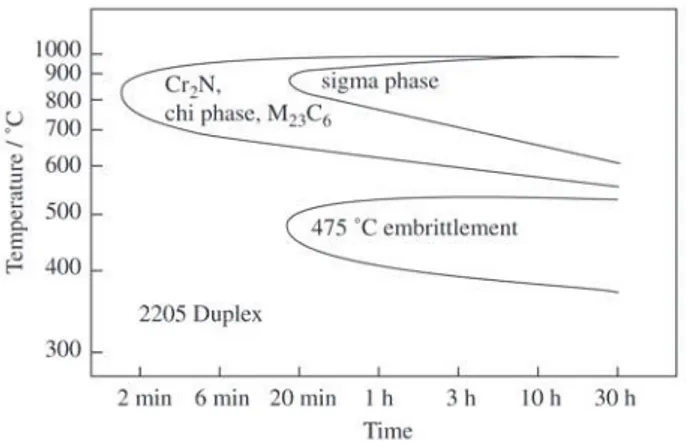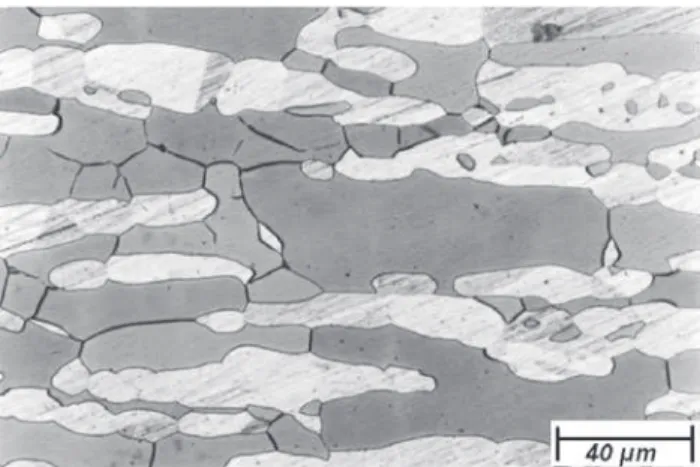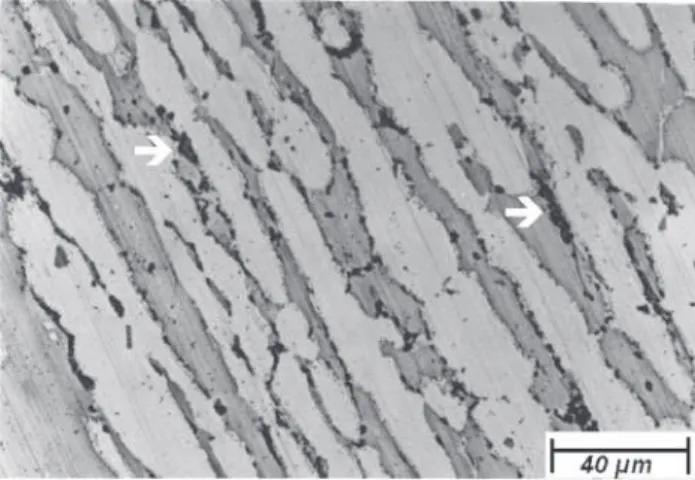Toughness of the UNS S31803 Duplex Stainless Steel Aged Treated at 850 °C
*e-mail: susana.lebrao@maua.br
Microstructural Characterization and the Effect of Phase
Transformations on Toughness of the UNS S31803
Duplex Stainless Steel Aged Treated at 850 °C
Igor Zucatoa, Margarete C. Moreiraa, Izabel F. Machadob and Susana M. Giampietri Lebrãoa*
a Escola de Engenharia Mauá
Praça Mauá, 1, 09580-900 São Caetano do Sul - SP, Brazil
b Departamento de Engenharia Mecatrônica e de Sistemas Mecânicos da EPUSP Av. Prof. Mello Moraes, 2231, 05508-900 São Paulo - SP, Brazil
Received: September 27, 2001; Revised: July 10, 2002
Duplex stainless steels, with ferritic-austenitic microstructure, have excellent mechanical prop-erties and corrosion resistance. However, when duplex stainless steels are exposed to tempera-tures between 600 and 1000 °C, some phase transformations can occur such as chromium nitrides precipitation, chromium carbides precipitation and the sigma phase formation. The formation of such compounds leads to loss in both corrosion resistance and fracture toughness. The negative effects of the formation of chromium nitrides, carbides and the sigma phase are due to the chro-mium depletion in the matrix. The phase transformations cited above occur initially at ferritic-austenitic interfaces and at the grain boundaries. The aim of this work is to identify and character-ize the phase transformations, which occur when aging heat treatments are carried out at tempera-tures at which the kinetics is the fastest for the reactions mentioned. At first, the samples were annealed at 1100 °C for 40 min. The aging heat treatments were then carried out at 850 °C for 6, 40 e 600 min. Microstructural characterization was done by using optical microscopy with differ-ent etchings, in order to iddiffer-entify each phase formed in the duplex stainless steel during aging heat treatments. The toughness was also evaluated by using Charpy impact test. Impact tests show that loss of toughness was related to phase transformations.
Keywords:duplex stainless steel, the sigma phase, toughness
1. Introduction
The duplex stainless steels, with ferritic-austenitic micro-structure, have better corrosion resistance than the auste-nitic stainless steel and better mechanical properties than the ferritic stainless steel1. However, when these steels are
exposed to temperatures ranging from 300 to 500 °C the α’ phase formation can occur. At higher temperatures other solid-state phase transformations may also occur. At tem-peratures ranging from 500 to 1000 °C (Fig. 1), phase trans-formations such as the sigma phase formation, chromium nitrides and carbides precipitation are favored2.
The occurrence of these phases can often cause loss of toughness and a decrease in corrosion resistance. Especially
the sigma phase formation has been the object of many stud-ies. The sigma phase presents the fastest kinetics in the range of temperatures reached during welding or thermo-mechani-cal processing4-6.
The sigma phase is a hard and fragile one and its forma-tion causes loss of toughness as described in reference2.
Moreover, for sigma phase consumes chromium and mo-lybdenum of the matrix, which leads to the depletion in these elements. As a result, there is a loss in corrosion resistance7.
In the Fe-Cr-Ni systems, the sigma phase has a Fe-Cr com-position and a tetragonal crystalline structure with 30 at-oms per unit cell8. Depending on the alloy composition, the
tung-sten. In a general way, the ferrite stabilizing alloy elements favor the sigma phase formation. Molybdenum, for instance, which is generally added to duplex stainless steels to im-prove pitting corrosion resistance, also favors the sigma phase formation7. Besides the chemical composition, other
factors can propitiate the sigma formation such as grain size - the smaller the grain size the greater the tendency towards the sigma formation. The sigma phase is more easily formed in high energy regions such as grain boundaries and inter-faces2. The temperature of annealing heat treatment
influ-ences the sigma phase formation in two ways: Higher an-nealing temperatures cause an increase in grain size, which reduce the tendency towards the sigma phase formation. On the other hand, at higher temperatures, high-tempera-ture-ferrite can occur, facilitating the sigma phase forma-tion during aging heat treatments. The precipitaforma-tion of car-bides (M23C6), can also occur in duplex stainless steel, and can present the same negative effects caused by the forma-tion of the sigma phase. The M23C6 precipitation also oc-curs in regions of high energy. Nitrides also occur in stain-less steel. The main nitrides that occur in stainstain-less steel are CrN and Cr2N2. In duplex stainless steel, the precipitation
of Cr2N type nitrides is favored in the ferrite-austenite in-terfaces. However, its precipitation has also been observed in ferrite-ferrite boundary2,5.
The identification and the characterization of the sigma phase, of the chromium carbides and of the chromium ni-trides as well as of other phases can be made by using sev-eral complementary techniques of microstructural analy-sis, such as the X-ray diffraction. However, efficient indi-rect techniques are used in the verification of the occur-rence of phase transformations, such as the Vickers microhardness and the Charpy impact test. The identifica-tion of phases using optical microscopy can also be made.
Optical microscopy is one the most important and also ac-cessible complementary techniques. The identification of the phases by its morphology and the colour acquired after the metallographic etching can be made in a conclusive way because many of the phase transformations occurred dur-ing agdur-ing heat treatment are well known9.
The aim of this work is to characterize the phase trans-formations in duplex stainless steel after aging at 850 °C, as well as to show a relationship between phase transfor-mations and the loss of toughness. In this study the duplex stainless steel UNS S31803 was used. The samples were annealed at 1100 °C for 40 min and later aged at 850 °C for different periods of time. A metallographic procedure was also developed for microstructural characterization and iden-tification of the phases. The procedure developed consisted of using three types of metallographic etchings. Each etch-ing disclosed with differentiated intensity and characteris-tic colors the morphology of the phases in the steel, facili-tating their identification.
2. Experimental Procedure
The chemical composition of the UNS S31803 (22%Cr-5%Ni) ferritic-austenitic duplex stainless steel studied is shown in Table 1. The samples were withdrawn from a rolled sheet.
The stainless steel studied was solution annealed at (1100 ± 3) °C for 40 min. After the annealing heat treat-ment was done, the samples were aged at (850 ± 3) °C for 6, 40 and 600 min. All the heat treatments were carried out in a muffle and were followed by quenching in water.
The metallographic sample preparation consisted of grinding with # 600 emery paper, 1 µm diamond polishing and further etching. Different etchings were used to char-acterize the microstructure of the samples after annealing and aging heat treatments. The procedure is described as follows:
1. Behara II. Austenite and ferrite have different colours after etching with Behara II for 15 s. Ferrite becomes blue and austenite yellow.
2. KOH. The electrolytic etching composition was a so-lution of KOH 10 N. 2.5 V was applied for about 60 s in the samples inside the solution of KOH. This etch-ing differentiates the sigma phase from the other phases.
Table 1. Chemical composition (wt %) of the UNS S31803 steel.
C Si Mn P S Cr Ni Mo N
max max max max max
0.03 1.0 2.0 0.030 0.015 22 5.5 3.2 0.18
Toughness of the UNS S31803 Duplex Stainless Steel Aged Treated at 850 °C
3. NH4OH. The electrolytic etching with NH4OH was done by applying 1.5 V in the sample for 40 s. This etching differentiates carbides and nitrides from the other phases.
The microstructures were analysed by using mainly optical microscopy. The other technique used to identify phase transformations in the steel studied was the Charpy impact test. The impact test measures the energy absorbed during impact and gives a relationship between the type of material and its toughness. The test was carried out accord-ing to ASTM E-23 Standards (1998)10.
3. Results
Annealing heat treatment
Table 2 shows the result of the Charpy impact tests after annealing at 1100 °C for 40 min.
After annealing the samples were etched with different etchings. Figure 2 shows the results of the annealing sam-ples after the etching with Behara II. Two phases are distin-guishable. The yellow phase (lighter) is austenite and the blue(darker) one is ferrite.
Aging heat treatments
The phase transformations, which occurred in the first few minutes of the aging heat treatments, caused a signifi-cant loss in toughness.
Table 3 shows the result of the Charpy impact tests after annealing at 850 °C for 6 min, 40 min and 600 min. The results of aging heat treatments are shown in Fig. 3 to 8.
Figures 3, 4 and 5 show the microstructures of the sam-ple aged at 850 °C for 6, 40 and 600 min, respectively. The samples showed in Figs. 3, 4 and 5 were etched with KOH
Table 2. Results of the Charpy impact tests of the sample annealed.
Energy absorbed during
Sample Charpy impact test (J)
Annealed at 1100 °C > 368*
for 40 min
* The others values are above Charpy Impact Machine Test Scale.
Table 3. Results of the Charpy impact tests of the samples aged at 850 °C.
Samples aged at Energy absorbed during
850 °C (min) Charpy impact test (J)
6 264 ± 46
40 80 ± 26
600 75 ± 10
Figure 3. Optical microscopy. Sample aged at 850 °C for 6 min and quenched in water. The ferrite regions are darker than the austenite ones. The sigma phase formation occurred mainly in the ferrite-austenite interface. The arrow indicates the sigma phase. Etching: KOH solution.
Figure 2. Optical microscopy. Sample annealed at 1100 °C for 40 min and quenched in water. The austenite is yellow (lighter) and ferrite is blue (darker). Etching: Behara II.
solution that differentiates the sigma phase from the car-bides and nitrides. Chi phase is also etched with KOH. An increase in the amount of the sigma phase can be observed in longer aging heat treatments.
4. Discussion
The annealing heat treatment was carried out at an ordi-nary temperature of annealing for stainless steels. The Behara II etching differentiates very clearly the ferritic from the austenitic regions in the annealed sample. It can be ob-served that volumetric fractions of ferrite and austenite are almost the same in the sample annealed. In the aged sam-ples, the use of different etchings made it possible to distin-guish the sigma phase formation from carbides and nitrides precipitation.
Figure 7. Dark field, optical microscopy. Samples aged at 850 °C for 40 min and quenched in water. The brighter regions indicate chromium nitrides and carbides precipitation. Etching: electrolytic etching with NH4OH.
Figure 6. Dark field optical microscopy. Samples aged at 850 °C for 6 min and quenched in water. The brighter regions indicate chromium nitrides and carbides precipitation. Etching: electrolytic etching with NH4OH.
Figure 5. Optical microscopy. Sample aged at 850 °C for 600 min and quenched in water. The ferrite grains regions are darker than the austenite ones. The sigma phase formation occurred mainly in the ferrite-austenite interface. The arrow indicates the sigma phase. Almost all ferrite was consumed in the sigma phase formation. Etching: KOH solution.
Figure 4. Optical microscopy. Sample aged at 850 °C for 40 min and quenched in water. The ferrite regions are darker than the austenite ones. The sigma phase formation occurred mainly in the ferrite-austenite interface. The arrow indicates the sigma phase. Etching: KOH solution.
The aging heat treatments were carried out at the tem-perature of fastest kinetics of the phase transformations for the steel studied. At 850 °C, the beginning of sigma phase formation takes only few minutes, but is somewhat slower than the precipitation of carbides and nitrides. Chromium carbides and nitrides precipitation takes only few seconds. In the figures showed could be observed carbides and ni-trides precipitation occurred almost completely in the first few minutes. On the other hand, the sigma phase formation took longer than 40 min.
Toughness of the UNS S31803 Duplex Stainless Steel Aged Treated at 850 °C
Figure 8. Dark field, optical microscopy. Samples aged at 850 °C for 600 min and quenched in water. The brighter regions indicate chromium nitrides and carbides precipitation. Etching: electrolytic etching with NH4OH.
favoured by the decrease in the solubility of carbon and nitrogen in austenite at temperatures below the annealing temperature. Earlier studies5 have showed that the carbide
precipitated in the UNS S31803 is of the M23C6 type. This kind of carbide tends to appear in low carbon stainless steels4. The case of nitrides, Cr
2N precipitation is expected.
It is important to mention that carbides and nitrides pre-cipitation also depends on the content of these chemical elements. Higher volumetric fractions of chromium nitrides are expected as compared to the chromium carbide. How-ever, the techniques used cannot distinguish nitrides from carbides.
The sigma phase occurs after chromium nitrides and carbides precipitation. The sigma phase formation in ferritic-austenitic duplex stainless steels can be described by the eutectoid transformation of ferrite into the sigma phase plus austenite as follows: α → σ + γ. The sigma
phase particles nucleated on the ferritic-austenitic inter-faces and grew inwards into the ferritic phase. The sigma phase presented massive morphology and the particles were very large when compared to chromium carbides and nitrides. During the longer aging heat treatments, the sigma phase consumed almost the ferrite available. On the other hand, the austenite of 22%Cr-5%Ni duplex stainless steel, with ordinary levels of nitrogen, does not transform dur-ing agdur-ing heat treatments.
The Charpy impact tests and microestrutural characteri-zation lead to the conclusion that chromium carbides and nitrides cause a decrease of toughness but the effect of the sigma phase formation is stronger. Volumetric fractions of about 5% of the sigma phase are enough to render fragile the studied steel6.
5. Conclusions
1. The use of different etchings made it possible to dis-close almost all the phases in the microstructure of the studied stainless steel. Two mechanisms of phase trans-formations were identified: chromium nitrides and car-bides precipitation and the sigma phase formation. 2. Aging heat treatments at 850 °C for more than 6 min
rendered fragile the steel. The chromium carbides and nitrides precipitation certainly cause loss of toughness as well as sigma phase formation.
3. The Charpy impact test cannot be used to quantify or identify the sigma phase formation.
Acknowledgments
We are thankful to Instituto Mauá de Tecnologia for fi-nancial support; to Sandvik do Brasil for supplying the stain-less steel studied.
References
1. Reick, W.; Pohl, M.; Padilha, A.F. In: Seminário Brasileiro sobre aços inoxidáveis , 3., São Paulo, 1992. Anais. São Paulo, ABM, 1992, p. 1-19.
2. Machado, I.F. Transformações de fase no estado sólido em alguns aços inoxidáveis austeníticos e ferríticos-austeníticos (dúplex) contendo altos teores de nitrogênio.
Tese apresentada à Escola Politécnica da Universidade de São Paulo para obtenção de título de Doutor em Engenharia, 1999.
3. Sedriks, A.J. Corrosion of Stainless Steels, 2nd edition, John Wiley & Sons, 1996.
4. Padilha, A.F.; Guedes, L.C. Aços inoxidáveis austeníticos microestrutura e propriedades. São Paulo, Hemus, 1994. 5. Ramires Londoño, A.J. Estudo da precipitação de nitreto de cromo e de fase sigma por simulação térmica da zona afetada pelo calor na soldagem multipasse de aços inoxidáveis duplex. Dissertação Mestrado apresentada à Escola Politécnica da Universidade de São Paulo para obtenção de título de Mestre em Engenharia, 1997. 6. Kobayashi, D.Y. Efeito da fase sigma na resistência à
corrosão por pite de aços inoxidáveis duplex, Tese de Doutorado apresentada à Escola Politécnica da Universidade de São Paulo, São Paulo , 1995.
7. Maehara, Y.; Koike, M.; Fujino, N.; Kinitake, T. Trans-actions of The Iron and Steel Institute of Japan, v. 23, p. 240-246, 1983.
8. Hall, E.O.; Algie, S.H. Journal of The Institute of Metals, v. 94, p. 61-88, 1966.
9. Roberti, R.; Silva, G. Sigma phase detection by metallographic etching ; Cattedra di Siderurgia Politecnico di Milano – from the metallographer’s note-book- Avesta Stainless Bulletin nº 3, 1980.



